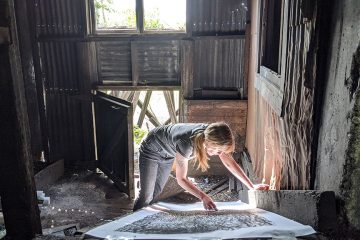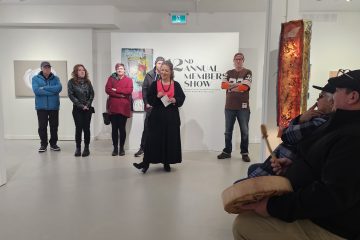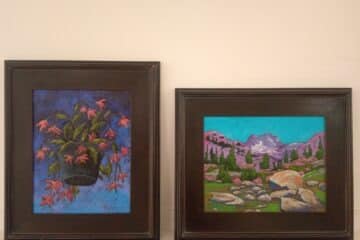Contemporary responses to Sybil Andrews
Sybil Andrews was a character unlike any other who was well known for her incredible work ethic, life of pioneering and determination, and highly expressive artworks that capture the essence of the times and places she lived. There exists a legacy of exceptional research and exhibition-making that honours her name. 1 Finding Sybil: Contemporary Responses to Sybil Andrews, seeks to add to this ongoing dialogue by examining the artwork and legacy of Sybil Andrews through the creative responses of five contemporary artists. They come from varied backgrounds and perspectives, as well as approaching artistic practice through different mediums.2 The curatorial method is based on a relational approach, bringing together diverse artists who gain a better understanding of Sybil Andrews through embodied knowledge.3 This knowledge is gained through the experience of making art, a performative form of research.4 The artists contribute to an expanded understanding of Andrews’ legacy by drawing relationships across mediums, and accentuating changes to society and culture. The audience experience then becomes multi-layered; encompassing art and objects from Sybil Andrews’ hand as well as art made contemporaneously by Nicole Crouch, Karver Everson, Jake James, Kari Kristensen, and Marni McMahan, who have been ruminating on her memory and the lessons that endure in her absence.
The choice to make space for five diverse voices and their embodied responses is a deliberate opening that allows for the introduction of new ways of understanding a well known figure and the history surrounding her life. This form of dialogue expands the conversation we can have because of the multiple lenses of experience the artists bring. The audiences that visit the exhibition will have the benefit of learning about Sybil Andrews through the responses of the artists. Taking this non-traditional approach to art history research privileges experience, deepens audience understanding of the intimate processes of artmaking, and demonstrates firsthand the ways artists relate to one another across time and space. A relational curatorial approach decentralizes the focus away from the individual artist, thus opening opportunities for shared understanding, communal experience, and recognition.
We invited a range of voices that illuminate important aspects of Sybil Andrews’ creative life. Karver Everson, an interdisciplinary artist of K’omoks and Kwakwaka’wakw ancestry, represents an active Indigenous presence that is critical in responding to an artist who depicted First Nations culture and ceremony. Jake James is a blacksmith and sculptor whose work accentuates the movement iconic to Sybil’s work, drawing relationships across mediums and referencing her history as a labourer during the Second World War. Nicole Crouch’s work features a series of watercolour paintings that highlight the spiritual aspects of art. Kari Kristensen brings a strong contrast to Andrews’ curving oeuvre through her linocuts. Finally, Marni McMahan, a quilter from Quadra Island, highlights important elements central to our understanding of Sybil’s work ethic and artistic process. Quilting mirrors aspects of labour, planning, layering, and feminist practice in Sybil’s work, not to mention her artistic talent in embroidery.
Sybil Andrews didn’t follow the established roles or expectations placed upon women throughout the tumultuous century in which she lived. She made non-traditional choices in her personal and professional life. She was called upon to serve her country during World War I by apprenticing and working as a welder on the all-metal airplanes in London and Bristol; and, again in World War II as a shipbuilder near Southampton.5 Her regard for human labour comes through in her frequent treatment of working people and her care in rendering the dynamic movement and powerful energy produced from their unity. The story of her life suggests that she believed wholeheartedly in hard work, and dedicated her life to the pursuit of art as if she were chosen for that vocation: “She valued what she was doing because she worked hard and didn’t take any shortcuts. She had hard times and she was willing to sacrifice for something much greater than the outward trappings of a fancy home and fancy belongings…The simpler the environment the better. An artist’s life is a dedication. She likened it to a monastic experience. She would say it’s a vocation that you take on, you take it seriously, and you live it. An artist’s life is not a hard laborious chore. It’s a labour of love. And if the labour of love isn’t there then one shouldn’t be in it.”6The artists chosen to exhibit connected with this strength of will and character in their own way. Each of them is drawn to unique aspects of Andrews’ life, oeuvre, and character.
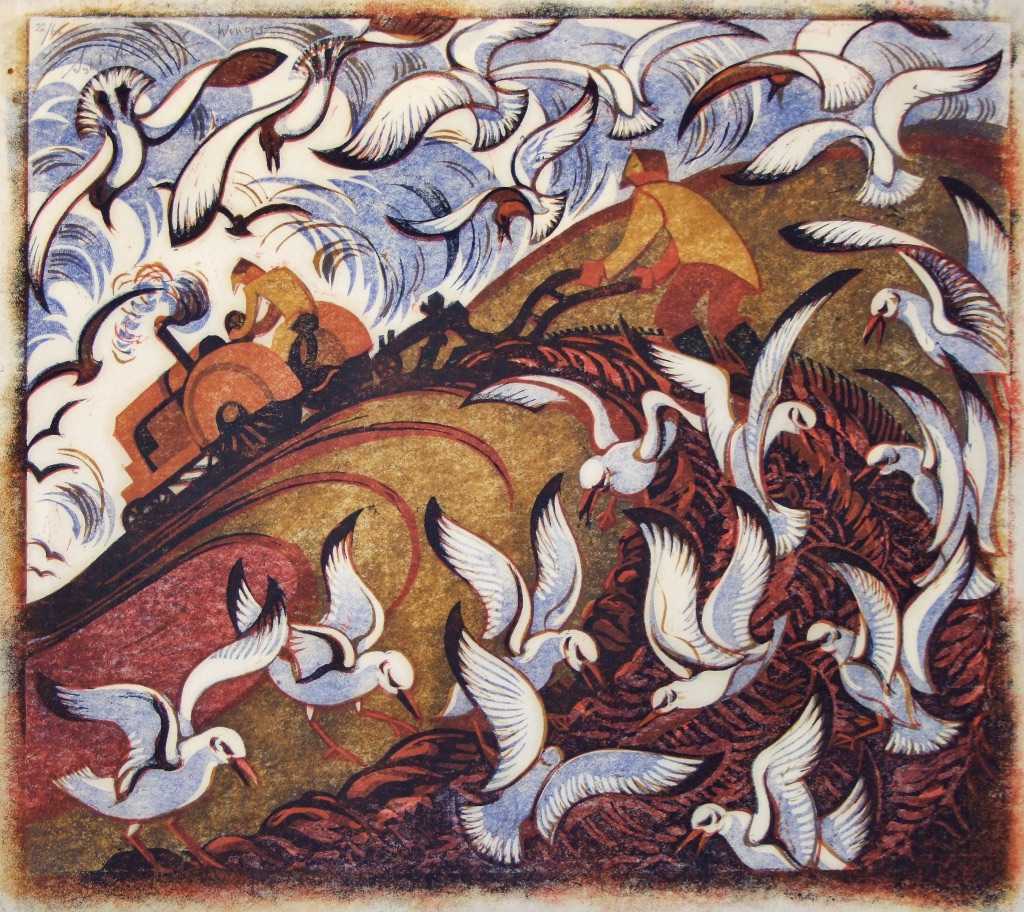
It is paramount that an Indigenous voice resonates through the exhibition. Andrews respected First Nations cultures; she thought they were very sophisticated, and admired their carving abilities.7 When she first arrived on Vancouver Island, Andrews was intimidated by the density and interconnectedness of the landscape, and in awe of the way First Nations culture fully integrated it in all its complexity. Andrews made work in response to Indigenous ceremonies that she witnessed. In her linocut Dance of the Birds, from 1975, there is a striking depiction of the fusion of regalia, mask, and movement that accentuates the spiritual energy and unity of the dancers.8 As such, Finding Sybil holds space for Karver Everson to respond to her legacy as a contemporary voice.
Karver Everson’s active Indigenous presence is a critical component in responding to Andrews who depicted First Nations culture and ceremony in her work. Everson worked in collaboration with artist Nicole Crouch. This relationship exemplifies Everson’s “fiercely” relational approach to knowledge gathering and art making.9 Each artist has worked on their own contribution to the exhibition, as well as working together to create a collaborative piece (Figure 3). They have taught each other, spent time working together-apart, and connected by sharing the perspectives and values that guide their art practices. In his own work and study Everson employs person-to-person knowledge transmission and sharing as a form of relational research.10 He works in the tradition of Northwest Coast artists who have learned craftsmanship and artform under masters and adhere to the protocols within that form that have existed since time immemorial. Coming together with Nicole Crouch has represented a blending of styles and world views, producing a wonderful visual dialogue on relationship building and the development of trust through collaboration.

Sybil Andrews promoted a strong sense of individualism in her art practice and teaching that held the artist’s voice in the highest regard. She expected each artist to have something to say and to say it in their own unique way; ideals that exemplify the western conception of the artist.11 Everson’s practice takes a significant departure from the modernist and western values espoused by Sybil Andrews that privilege individual voice and style. The artistic values of Everson are based upon millenia old Northwest Coast Indigenous traditions where artistic practice is unified by symbolic language, and practice is taught through apprenticeship into a tradition that is carried forward with respect and spiritual care. The preservation and transmission of culture are the highest priorities.
Everson’s use of aquamarine departs from the traditional palette and signals his engagement with contemporary design and culture. In addition, the subject matter of his work addresses emotional states, and perpetuates a positive message of self-determination.12 This is an uncommon theme, and the artist’s way of using the work to address relevant issues. Everson also employs glass in the series of masks Union, which is another departure from traditional materials. This imbues the moulded glass masks with a whole different meaning. The moulds were made from the original wood carving and the lost wax process produced the versions you see exhibited. The collaborative panel Benefit – Ripples in time and energy combines the carving of Everson with the painting of Crouch, creating a mutual coming together of two artists through their shared work.

Nicole Crouch has conducted her responses to Sybil Andrews in a series of 34 watercolour paintings May feel familiar in which she explores spirituality, community, and artistic labour (Figure 4). She approaches her practice as a queer artist whose work has an overarching lens of connective healing. After reading Andrews’ manifesto, Artist’s Kitchen, Crouch was drawn to her instructive calls for discipline, and has since utilized repetition in production to deepen investigations of subject matter. The medium of watercolour is an intersection between Crouch and Andrews, who created many watercolours herself. Crouch’s watercolours incite a curiosity in the viewer that transports us into each little world (Figure 5). The small size contributes to their mystery and precious quality. Some are luminous and teeming with spiritual energy; some depict landscapes pulsing with their own life force. The two artists share a remarkable ability to inject spirit into their work for the viewer to share.
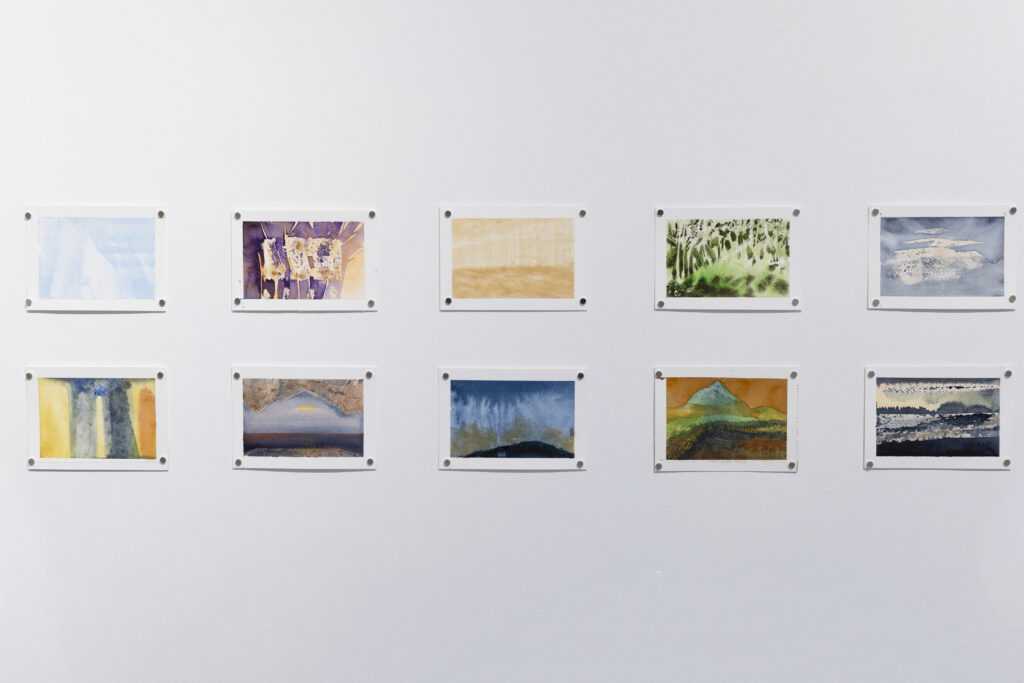
Crouch’s spiritual explorations are rooted in her upbringing in a home devoted to the Anglican Church and her work in supporting peoples’ end-of-life journeys as an art therapist. Sybil Andrews was a devotee of Christian Science and her faith was deeply interwoven through her work.13 Noted Andrews scholar Hana Leaper observes, “Andrews explicitly connected the spiritual element in subjective art with her religious faith.”14 She described subjective art as emotional in nature and spiritual because it originates from the mind, heart, and spirit. Looking back at her upbringing, Crouch finds gratitude in examples of community and making art with others: “Something special happens when you connect with yourself and connect to others.”15 As part of her research Nicole paid a visit to the Sybil Andrews Cottage. The profound experience reinforced values of community and art making; echoing the lasting effects of the cultural hub that Sybil and Walter Morgan created in their small cottage in a remote coastal town.

The wood panel she created with Everson Benefit – Ripples in time and energy, has been a source of inspiration and encouragement over the last several months (Figure 6). They have engaged in many conversations about their individual art practices and the lessons they have learned from Sybil Andrews, and exchanged lessons on techniques and approaches to their work. Upon first approaching the medium of wood and Everson’s carving as a water-colourist, Crouch felt intimidated; however her careful work and time spent getting to know the material has helped produce a powerful, symbolic gesture of cooperation and friendship.

Jake James has approached Sybil Andrews’ work from a technical perspective, creating a 3-dimensional composition that strongly echoes her approaches to movement. James is a British-born and educated blacksmith whose contribution accentuates the movement iconic to the artist’s oeuvre and her history as a welder working with metal (Figure 7). According to James, “the ‘energy’ in [Andrews’] work speaks directly to me as a blacksmith, given that the working process of my material (iron) is all about capturing the movement iron has as it is being forged. Her relationship to metal through her wartime work seems to come through in her paintings, some of her gesture and form leaps out at me as one who spent a lifetime working that material”.16
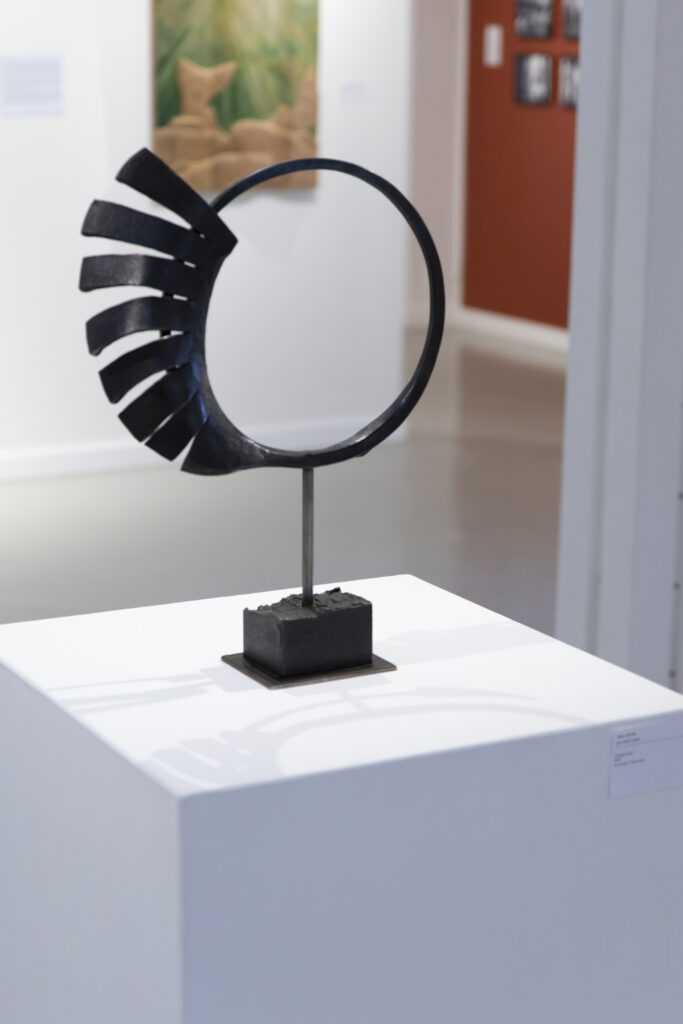
Sybil Andrews was employed as a welder during World War II, working on the first all-metal airplane and then on building ships: “Her war work provided many skills that attending art school might not have done, and she became part of the first generation of English women to participate in large-scale industrial labour beyond the mills.”17 This period in her life was formative, feeding her incredible work ethic and empathy for labouring people. James recognizes her familiarity with metallic material through the way she ably expresses gesture and form. Form and process are guiding his response to Andrews because of the way her work speaks so directly to him as a craftsperson.18 Approaching his sculptural work through a 2-dimensional lens has proven interesting and challenging: “Sybil’s work implies a deep sense of texture, something that will be at the forefront of my response to her work.”19 The accessibility of Andrews’ work drew James. This includes her treatment of subject matter; the relationship she creates between the viewer, the figures and the spaces they occupy; and, the sense of energy and spirit that she infuses into the work. As a contemporary blacksmith who shares similar passions and experience, James connected to Andrews’ relationship with iron and her work with architect Cyril Power.20 We never stop is James’ rumination on Andrews’ ability to create the thrilling sense of movement that has held audiences of her work captive since she began working in linocut.

Marni McMahan, a quilter from Quadra Island, highlights important elements central to our understanding of Andrews’ work ethic and artistic process. Quilting mirrors aspects of labour, planning, layering, and feminist practice in Andrews’ work, not to mention her talent in embroidery. One of Andrews’ great accomplishments in threaded art is a large silk tapestry on handspun and handwoven linen, the Banner of St. Edmund that she made for the cathedral of Bury St. Edmunds.21 Born and raised in Bury St. Edmunds and an active participant in the spiritual life of the town, such as pageantry plays, Andrews finished the extensive work in Campbell River and sent it to England as a gift.22
The first time McMahan saw Sybil Andrews’ artwork she was taken by her use of repeated shapes and lines that curved and converged. This repetition of lines and form conveys motion and power, something McMahan tries to do in her own work. In honour of Andrews’ aesthetic and technical choices McMahan has selected a limited and striking palette of colours for her quilts; she uses off-white grounds for some to emulate the Japanese tissue paper that Andrews printed on.23 In others she has chosen to repurpose linen from clothing, showing a great economy of materials; or, to explore the paring down of the subject even further, arriving at a silhouette-like interpretation (Figure 9). McMahan’s quilt series is born from studying the angular forms present in Andrews’ prints such as: Coffee Bar (1952), Peevies (1962), and Sledgehammers (1933).24

Participating in this exhibition has challenged McMahan’s practice and pushed her work in new directions. The result is artwork that has simpler and more powerful compositions. Andrews was a great proponent of bringing out the essence of a composition, and removing all extraneous detail.25 McMahan has done a deep study on variations of one composition. One can trace the evolution through material experimentation and the paring down of pictorial elements. The result is a compelling series of quilts that honour the principles Andrews worked by and that pay homage to Andrews’ dedication to motion and curvature.
Kari Kristensen, a Vancouver-based artist, provides unique perspectives that ruminate on the technical aspects of Andrews’ oeuvre through their shared medium, the linocut. Kristensen’s highly detailed, abstracted, monochromatic landscapes depart significantly from Andrews’ approach to the linocut, complexifying the dialogue through contrast (Figure 10). In her manifesto Artist’s Kitchen, Sybil Andrews said, “Life is a curve.”26 This vision manifests iconically in her linocuts and is carried throughout her entire career. In stark contrast to Andrews’ linocuts, Kristensen’s are composed entirely of straight lines and rendered in black and white. Kristensen reflects on ways she was challenged by Andrews’ visual strategy: “It’s said she had little patience for artists who drew the sky as a straight line. In her own words, ‘the clouds show the curve of the earth, everything is a curve reflecting the sphere of the earth, movement is paramount’. The basic shape for many of her compositions is a curving line. My own work is the antithesis of that, it’s full of straight lines. There’s not a curve in the bunch. So the challenge for me was to show that movement is possible with straight lines, that the curve can still compositionally exist within a straighter framework. I’d like to hope Sybil would approve.”27
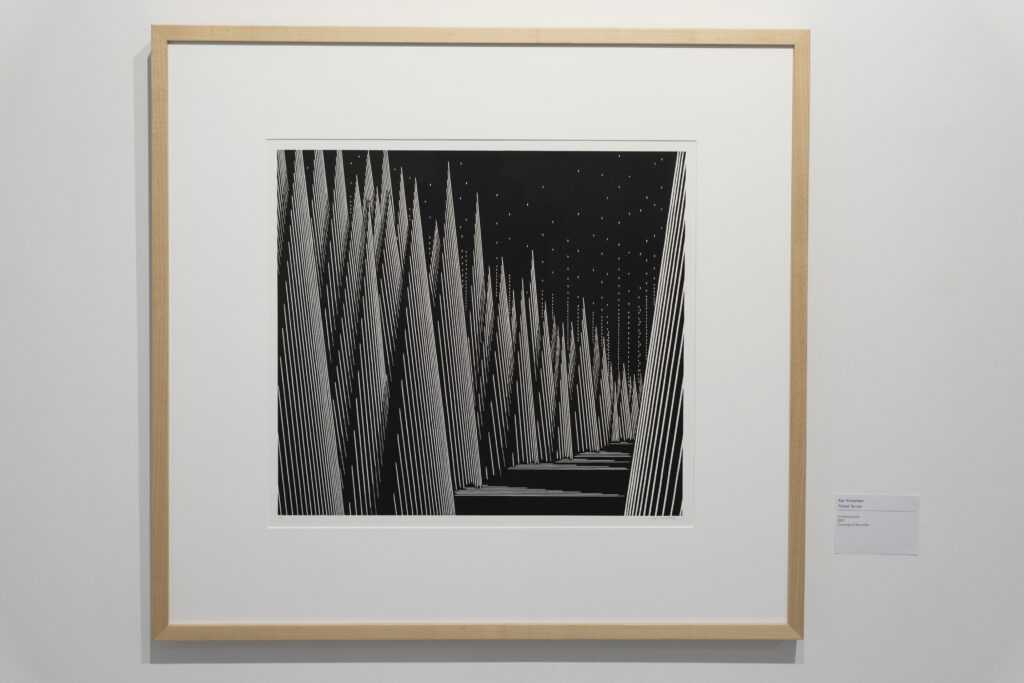
Sybil Andrews took up the linocut as a result of her work and tutelage at the Grosvenor School of Art.28 Claude Flight, who taught Andrews, believed in the linocut as a “democratic art form,” accessible to artists through low-cost materials and tools.29 Compelled by Andrews’ early dedication to a modernist cause that strove to say something of value, Kristensen connects with the desire to portray more than just pretty pictures: “In her 1924 manifesto with Cyril Power, Sybil declared her focus to be on the suppression of the non-essential and through bold lines, shapes, rhythms and patterns she aimed to portray what she felt rather than what she saw. In my own studio practice over the last couple of years, my work has evolved simply from portrayal of landscape to using the landscape as a jumping off point, a reference point from which to incorporate larger feelings and ideas about not just landscape but the human condition”. 30(Figure 12).
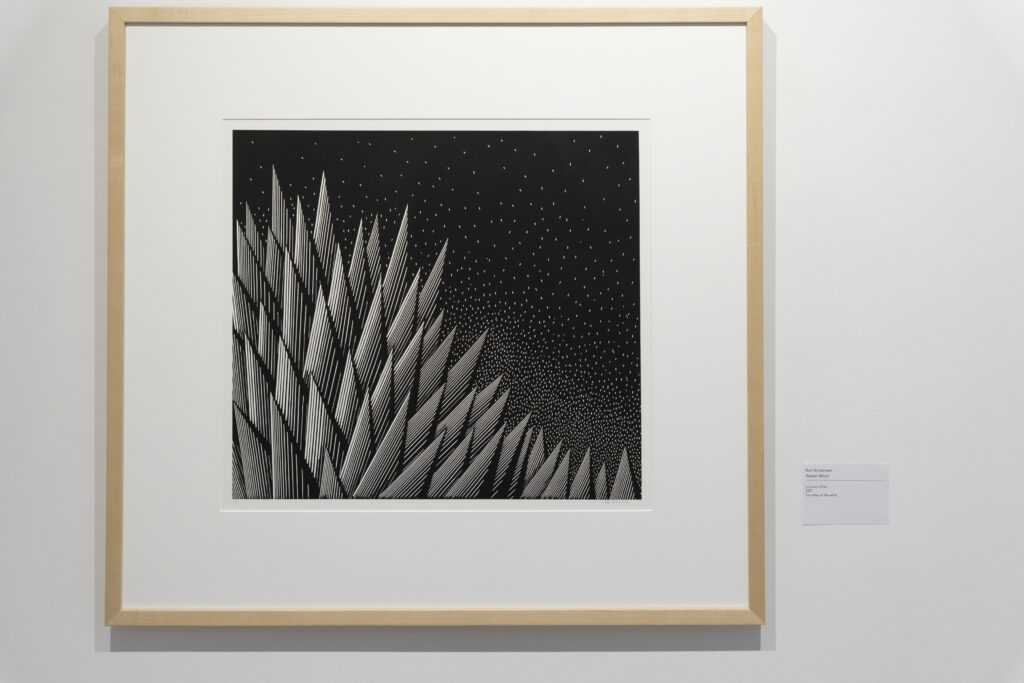
Although Andrews and Kristensen share a medium and a love of patterns, there have been many innovations in technology and materials that make their practices markedly different in execution. “Technically, I’d say I have the edge on Sybil merely because there have been advancements in printmaking since her time. Her favourite tool was one Walter made out of part of an umbrella! Now, there are sets of incredibly sharp knives forged just for linoleum work. And the ink is also formulated specifically for relief prints–no more pulling oil paint out of a tube like Sybil did. I use an ink that has a specific pigment count for printmaking. All that to say that the technical gives me an unfair advantage. And I don’t think the advantages stop there. I approached making a response piece more from a feminist lens, although I can never really escape the queer lens, being gay myself. For me that meant putting aside the vorticism and masculine agenda in the work and looking for something else we had in common. What that boiled down to for me was patterning. A bi-product of growing up gay in a hostile world is my particular type of Obsessive Compulsive Disorder, one in which I count and trace things repeatedly, one that I think led me like a magnet to linoleum printing in which structure, pattern and order are key.”31
The exhibition Finding Sybil: Contemporary Responses to Sybil Andrews aims to broaden ways of looking at the legacy of artist Sybil Andrews through the embodied experiences of five living artists: Nicole Crouch, Karver Everson, Jake James, Kari Kristensen, and Marni McMahan. The artists were commissioned to investigate Andrews and to respond to aspects of her technical practice, artistic oeuvre, artistic values and approaches, and biographical history. Utilizing a relational curatorial method and embodied approaches to art research allowed for the integration of new voices and perspectives on a well-known and documented artist. Decentralizing the focus away from a singular artistic figure made space for the appreciation of other artistic voices and the way that they connect with Sybil Andrews. This became a powerful demonstration of the way her legacy functions at this moment, allowing for non-linear connections to be made across time and space. The inclusion of Indigenous, gay, and female voices unafraid to speak openly of their lives, their choices, and their artistic practices marks a strong departure from predominate social and cultural conditions during Andrews’ life. Yet her work spoke with a great force of will to them, showing its transcendental qualities. Privileging embodied experiences through the artists’ acts of making has been effective in bringing the audience to understand aspects of Andrews’ work in entirely new and unique ways. The diversity of expression, materials, and approaches is exemplified by the relational method of examining the work of Andrews through the myriad lenses of a seemingly disparate group of artists that connect through their relationships to the subject matter and subsequent self-discovery. This can also account for the diversity of material approaches and ways of connecting to Andrews’ work that have created such a varietal expression of the impacts of her life and work. Some moving aspects of the exhibition experience are the living artists’ acknowledgements of Andrews’ influence as a presence. She has been alive to us all throughout this process.
Works Cited
1- I would like to acknowledge a selection of the shows that have been bringing attention to Sybil Andrews for over a decade, establishing a dialogue to which Finding Sybil can contribute. Sybil Andrew: Art and Life curated by Hana Leaper at the Glenbow Museum and Archives in Calgary, AB from October to January 2019. A Study in Contrast: Sybil Andrews and Gwenda Morgan at the Art Gallery of Greater Victoria in Victoria BC in the winter of 2015. Sybil Andrews – Linocuts at the Osborne Samuel Gallery during the summer of 2015 in London, UK. Sybil Andrews at the Burnaby Art Gallery, organized by the Art Gallery of Greater Victoria, spring 2011. Rhythms of Modern Life: British Prints 1914-1939, which toured from the Museum of Fine Art, Boston, to the Metropolitan Museum of Art, New York and The Wolfsonian, Miami.
2- Finding Sybil: Contemporary Responses to the Art of Sybil Andrews is on view at the Campbell River Art Gallery from March 6 to May 1, 2021.
3- Maura Reilly, Curatorial Activism: Towards an Ethics of Curating (London, UK: Thames and Hudson, 2018), 29-31.
4- “The performative is understood as the constitution of meaning through acts and practices… The performative research method observes the conditions of meaning-production through detailed analysis of the social, spatial, structural, physical conditions of the act, whether it is intentional or unintentional.” Balazas Beothy, “Performativity.” Curatorial Dictionary. transzit.org/curatorialdictionary/index.php/dictionary/performativity/. Accessed January 22, 2021.
5- Sybil Andrews, Artist’s Kitchen (London, UK: R.K. Hudson, 1985), 210; Hana Leaper, Sybil Andrews Linocuts: A Complete Catalogue (Surrey, UK: Lund Humphries, 2015) 13, 34; Janet Nicol, On the Curve: The Life and Art of Sybil Andrews (Halfmoon Bay, BC: Caitlin Press Inc., 2019), 57-59.
6- Campbell River Arts Council, Remembering Sybil Andrews: Artist and Mentor, DVD. Directed by Ken Blackburn. (Campbell River, BC: Campbell River Arts Council, 2008), 33:00.
7- Museum at Campbell River. “Sybil Andrews III”. Youtube video Series. April 27, 2020. https://www.youtube.com/watch?v=YwKXoQ5ivE0&t=1231s&ab_channel=MuseumatCampbellRiver (Accessed October 28, 2020).
8-Ibid.
9- Karver Everson, in conversation with Nicole Crouch, January 11, 2021.
10- Ibid.
11- Andrews, 48, 63.
12- Karver Everson, interview with curator Jenelle Pasiechnik, February 16, 2021.
13- Nicol, 35.
14- Leaper, 31.
15- Nicole Crouch, interview with curator Jenelle Pasiechnik, January 15, 2021.
16- Jake James, interview with curator Jenelle Pasiechnik, January 25, 2021.
17- Leaper, 14.
18- James, interview.
19- Ibid.
20- Sybil Andrews took up the linocut as a result of her work and tutelage at the Grosvenor School of Art and her ongoing relationship with Cyril Power. Legend in Bury St. Edmunds records that Sybil Andrews met Cyril Power while she was sketching historic houses in the town square. His offer of help blossomed into a mentorship, and they became companions for nearly 20 years, having a profound influence on each other. See Hana Leaper Sybil Andrews Linocuts: A Complete Catalogue.
21- Leaper, 13.
22- Nicol, 13 and 17.
23- Marni McMahan. interview with curator Jenelle Pasiechnik. January 11, 2021.
24- Ibid.
25- Andrews, 45.
26- Ibid, 129.
27- Kari Kristensen, interview with curator Jenelle Pasiechnik. January 12, 2021.
28- Leaper, 25.
29- Nicol, 37-38.
30- Kristensen, interview.
31- Kristensen, interview.
